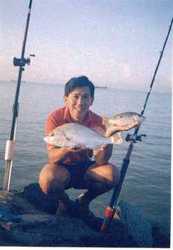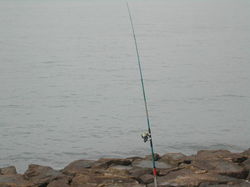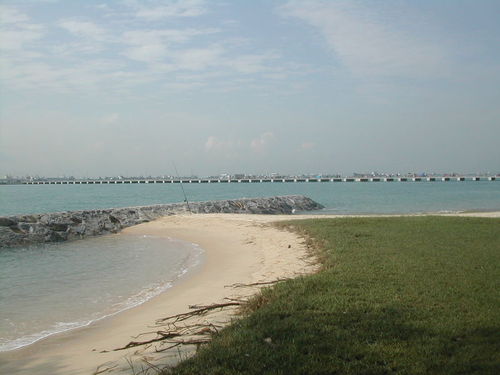How to start your beach fishing ?
How to start your beach fishing ?
How to choose a good spot ?
On a long stretch of open beach, always look for any river mouth or breakwater stone. The river mouth always attracted fishes to come close to feed as there will be plenty of sea creature hanging around. A breakwater stone will gave fishes to hide and taking cover during a strong current flow. A jetty or small pier will provide you a deep water spot where fishes will stay even on a low tide.
Baits
The freshness and quality of the bait is very important. So always get the best one if possible. Keep them fresh in a cooler box through out the fishing period is essential as our hot tempreture here will damage the freshness easily. Tube worm(sarong) will attract all sort of fishes to feed. But when buying them, try to see they are still alive. Dead worm will gave out a foul smell. Among the prawn types, peel grey prawn meat is the best. Fresh squid bait work well during the night but are more costly to buy. Try not to buy ready packed squid from supermarket shelve as they are well clean and has lost the scent needed for fishing. Instead buy it from wet market or fishery port.
When to go fishing ?
A monthly tide table is essential. You can get it from a tackle shop or check on the tide table provided by the Singapore Marinetime board. This tide information will tell you when is the high and low tide timing. For beach fishing, always start on a incoming tide. Fishes will follow the tide movement and come nearer to the shoreline to feed when the water is coming in. It will do the same and went out to the deeper water area when the tide is lowering. So even if you can just fish for a few hours, make sure you fish on the two hours before the highest tide and two hours after.
Tactics
Make sure you reach the spot at least two hours before the high tide to catch the golden timing of shore fishing. Fishes tend to feed before and after the high tide. If you missed that period, chances of a empty handed trip is high. Upon reaching the spot, quickly set up the tackle and cast out. Let your sinker sink to the seabed before you tighten the line. Make sure the line is always tighten all the time. This is to ensure if there is a bite, the hook will be more easy to set in with the help from the line tension between the sinker and the rod tip. After this you can rest the rod in the rod holder and the game is waiting for any bite. Checking your bait is important. You need to do it every ten minute or so on this golden period. Change it if the bait turn soggy or have eaten out by other sea creature. Remember fishes won't take a empty hook you presented. Keep you eye on the rod tip if possible. Any movement on the rod tip mean something below is eating your bait. A rod tip bend or line loose indicate a fish bite and likely a hookup. You need to pickup the rod and gave a hard strike first upon seeing this in order to set the hook. Failing to do so may result lost of the fish. If the fish is pulling back with strong power and your rod is bending like a curve, it mean the fish is big and you need to handle it carefully. Maintain a smooth drag on the reel will help you to win the final battle. Any over tighten on the drag will result in line breaking and the catch is lost. A night trip with a good running tide will gave you a better chance of a hookup. Fishes tend to come closer to the shore during darkness to feed. Prevent shinning bright light into the water or making loud noise while fishing at a water edge.
Tackles needed ?
If you are fishing from a beach, you need to cast your bait to a certain distance out into the deeper water area. So you need at least a 10ft or longer rod with a secure reel seat attached. Shorter rod can't do the job properly. For a beginner, best is not to choose a rod that is too stiff. A more flexible rod is more easy to cast and handle. Reel the best is get a medium size spinning or fixed spool one if you are a beginner. It make your casting more easy and less trouble of handling it. You need at least 20lbs mono line for surfcasting. Anything less than that will crack off easily during casting or when pulling the line free from a snag. A two hooks short snood bottom feeder rig is the most effective method. To tie your own rig you need stiff leader line. The stiff line will help to present your bait in a better position to attract the fishes after casting out. Size 4,5 and 6 bullet size sinker is best for surfcasting as the shape make easy during casting out and winding line back. For hooks, size 1/0 or a smaller size 2 long shank type with do the job. A rod holder or sand spike is needed to hold your rod at a vertical position after casting out. A small plier and scissor for unhook the fish and cutting line and bait.
Other Tips and Safety on the Beach
A head light is neccessary if you are doing night fishing. It keep your both hand free for baiting or holding the rod to fight a hookup. A light wind breaker and cap will keep you warm during the early hours. A dry clean clothe to wipe your hand after baiting is essential. A wet hand may result of a cutting finger during casting or a slippery hand can't hold the rod well. Bring a rain coat along will keep you dry if there is a down pour. Some hot drink will keep you warm and a wake during the golden hours. Bring extra sinker and line will keep your fishing going if there is a snag or line break. Always have extra bait to spare incase the bite come late. A full stomach will keep your moral high and enjoying during fishing. A buddy or two to fish along with will keep you accompany and chat during the waiting period. It also create more excited if your buddy got a bite or a hookup as more rods always has more chances. Rod tip luminuse light is needed at night for easy bite detection. A insect rebellion spray will help to keep the mosquito away and make your trip more pleasent and enjoyable.
Safety First
When you reach the spot, always make the habbit of checking where is the highest water mark leave by the high tide and stay a distance away from it. It doesn't matter you are fishing on the beach or ontop of a breakwater stone. This will keep you and your things dry during the high tide or a sudden coming big wave cause by passing ship. Before you cast your rod, always look around and see that your ark of casting is clear from all thing. Gave warning or indication to anyone who is nearby. Keep cutter, hooks, baiting needle, scissor and all sharp things out of reached from children if you are on a family outing. If your line got a snag, try to pull it free with your dry hand slowly. Do not used your rod to jerk or flick it. Doing so might cause the hook to suddenly free up and the sinker with the hook might fly toward your direction and may accidentally hook on you or anyone standing nearby. Just cut your line if you can't break it by pulling. Do not attempt to go down into the water to free it. Most water edge are slippery and dangerous.


